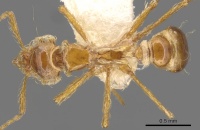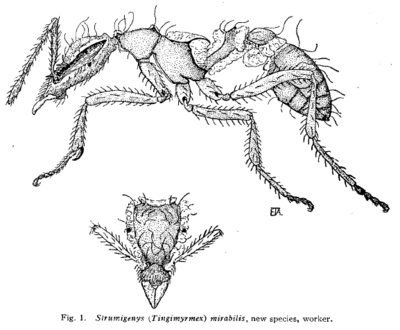Strumigenys mirabilis
| Strumigenys mirabilis | |
|---|---|

| |
| Scientific classification | |
| Kingdom: | Animalia |
| Phylum: | Arthropoda |
| Class: | Insecta |
| Order: | Hymenoptera |
| Family: | Formicidae |
| Subfamily: | Myrmicinae |
| Tribe: | Attini |
| Genus: | Strumigenys |
| Species: | S. mirabilis |
| Binomial name | |
| Strumigenys mirabilis Mann, 1926 | |
Mann found the type material under a stone.
Identification
The only member of the Strumigenys mirabilis-group.
Keys including this Species
Distribution
Latitudinal Distribution Pattern
Latitudinal Range: 1.424166667° to -14.5°.
| North Temperate |
North Subtropical |
Tropical | South Subtropical |
South Temperate |
- Source: AntMaps
Distribution based on Regional Taxon Lists
Neotropical Region: Bolivia (type locality), Brazil.
Distribution based on AntMaps
Distribution based on AntWeb specimens
Check data from AntWeb
Countries Occupied
| Number of countries occupied by this species based on AntWiki Regional Taxon Lists. In general, fewer countries occupied indicates a narrower range, while more countries indicates a more widespread species. |

|
Estimated Abundance
| Relative abundance based on number of AntMaps records per species (this species within the purple bar). Fewer records (to the left) indicates a less abundant/encountered species while more records (to the right) indicates more abundant/encountered species. |

|
Biology
Castes
Nomenclature
The following information is derived from Barry Bolton's Online Catalogue of the Ants of the World.
- mirabilis. Strumigenys (Tingimyrmex) mirabilis Mann, 1926: 105, fig. 1 (w.) BOLIVIA. Combination in Tingimyrmex: Brown, 1948e: 111; in Pyramica: Bolton, 1999: 1673; in Strumigenys: Baroni Urbani & De Andrade, 2007: 124. See also: Bolton, 2000: 206.
Unless otherwise noted the text for the remainder of this section is reported from the publication that includes the original description.
Description
Worker
Length 2.25 mm.
Head, excluding mandibles, nearly two times as long as broad and about twice as broad at occiput as in front, sides posterior to eyes nearly straight and parallel, in front of eyes convergent, then very feebly sinuate and slightly divergent to anterior border; occipital corners angulate, border shallowly emarginate; vertex rather strongly convex. Clypeus broadly convex, arcuate at anterior border. Mandibles a little more than half as long as head, slender, acuminate. Antennal scapes slender basally, somewhat thickened at apical half, attaining occipital corners; first funicular joint thicker and scarcely shorter than the second, which is a little more than three times as long as broad and subequal to the third, fourth joint two thirds as long as the terminal, which is subfusiform and pointed at tip. Eyes small, very convex, situated on lower margin of antennal fossa, well behind middle. Pronotum nearly flat, broadest in front, sides moderately arcuate, anterior angles with thick, blunt spines longer than broad, posterior angles with elevated, broad, lamellate triangular teeth, the bases of which continue as elevated side margins to the strongly sloping mesonotum. Epinotum slender, the base shorter than the declivity and rounding into it, strongly margined at sides, the margins prominently expanded and angulate between basal and declivous portions, nearly parallel on the declivity, nearly convergent anteriorly on the base, making that portion from above triangular in shape and less than twice as long as broad. Petiolar peduncle slender, longer than the node; node in profile with a rather concave dorsal surface, as long as the sloping anterior surface and much shorter than the posterior surface; from above transverse, prominently angulate at sides, subangulate in front, exposed posterior outline arcuate. Post petiole nearly as broad as base of gaster and more than three times as broad as petiole, less than twice as broad as long, evenly convex above, anterior border straight, sides arcuate, posterior border in three subequal parts, the lateral lines feebly and the median distinctly emarginate. Legs long and rather slender.
Exposed areas smooth and shining, dorsal surface with sparse, exceedingly long and flexuous hairs, mingled on the head and thorax with shorter, coarser and strongly curved erect hairs; legs with stiff, moderately long, curved, semirecumbent hairs.
Bolton (2000) - TL 2.6-2.9, HL 0.68-0.70, HW 0.50-0.56, CI 75-80, ML 0.14-0.15, MI 20-21, SL 0.42-0.44, SI 76-84, PW 0.39-0.40, AL 0.72-0.76 (3 measured).
[Dimensions just given include lamellae of head and body. For the same 3 workers, excluding the lamellae, measurements differ thus: HL 0.64-0.66, HW 0.38-0.40, CI 59-62, MI 22-23, SI 105-115, PW 0.30-0.32.] Entire ant smooth and shining. Node of petiole in dorsal view small, much broader than long and with a posterior spongiform collar whose width from front to back is about equal to the dorsal length of the node. Postpetiole massive, its disc many times the area of the petiole node; petiole node maximum width ca 0.18, postpetiole disc maximum width ca 0.38. Upper scrobe margin throughout its length with a continuous subspongiform lamella that projects laterally and is about 0.12-0.16 wide, its outer margin irregular. Lower scrobe margin behind eye similarly lamellate, the upper and lower lamellae continuous around the posterior angle of the scrobe. Occipital margin in full-face view with a transverse lamella that is ca 0.04 wide. This lamella continues down the side of the occipital surface to the posterior ventrolateral angle of the head capsule; occipital lamella is separate from lamella that circumscribes the scrobe. Pronotal humerus with a broad flat laterally projecting tubercle from which the flagellate humeral hair arises. Anterior margins of these tubercles with a lamella that extends across the anterior pronotum, broadest at the tubercles and narrowing medially. Mesonotum with a low lamina on each side from which the long flagellate hair arises. Propodeum with a near-vertical dorsolateral lamella on each side that is about 0.10 tall at maximum. This lamella extends the length of the segment and continues posteriorly along the top of the vestigial propodeal spine. Lamella of propodeal declivity very broad, width from spiracle to apex ca 0.20, continuous with the dorsal propodeal lamella around the apex of the spine. Petiole dorsally with a tall cuticular crest that extends along the peduncle and up the anterior face of the node, terminating just behind the anterodorsal angle of the node. Legs in this species are relatively long, hind femur length ca 0.64, and the middle and hind femora and tibiae are noticably bilaterally compressed.
Type Material
Bolton (2000) - Syntype workers, BOLIVIA: Huachi, Beni (W.M. Mann) (Museum of Comparative Zoology) [examined].
References
- Baroni Urbani, C. & De Andrade, M.L. 2007. The ant tribe Dacetini: limits and constituent genera, with descriptions of new species. Annali del Museo Civico di Storia Naturale “G. Doria”. 99:1-191.
- Bolton, B. 1999. Ant genera of the tribe Dacetonini (Hymenoptera: Formicidae). J. Nat. Hist. 3 33: 1639-1689 (page 1673, Combination in Pyramica)
- Bolton, B. 2000. The ant tribe Dacetini. Memoirs of the American Entomological Institute. 65:1-1028. (page 206, figs. 142, 187 redescription of worker)
- Brown, W. L., Jr. 1948e. A preliminary generic revision of the higher Dacetini (Hymenoptera: Formicidae). Trans. Am. Entomol. Soc. 74: 101-129 (page 111, Combination in Tingimyrmex)
- Chaul, J.C.M. 2023. A new ant species of Strumigenys Smith, 1860 (Hymenoptera: Formicidae) from the Brazilian atlantic forest. Taxonomy 2023, 2, 221–231 (doi:10.3390/taxonomy3020016).
- Franco, W., Ladino, N., Delabie, J.H.C., Dejean, A., Orivel, J., Fichaux, M., Groc, S., Leponce, M., Feitosa, R.M. 2019. First checklist of the ants (Hymenoptera: Formicidae) of French Guiana. Zootaxa 4674, 509–543 (doi:10.11646/zootaxa.4674.5.2).
- Kempf, W. W. 1972b. Catálogo abreviado das formigas da regia~o Neotropical. Stud. Entomol. 15: 3-344 (page 250, catalogue)
- Mann, W. M. 1926. Some new neotropical ants. Psyche. 33:97-107. (page 105, fig. 1 worker described)
References based on Global Ant Biodiversity Informatics
- Fernández, F. and S. Sendoya. 2004. Lista de las hormigas neotropicales. Biota Colombiana Volume 5, Number 1.
- Franco W., N. Ladino, J. H. C. Delabie, A. Dejean, J. Orivel, M. Fichaux, S. Groc, M. Leponce, and R. M. Feitosa. 2019. First checklist of the ants (Hymenoptera: Formicidae) of French Guiana. Zootaxa 4674(5): 509-543.
- Kusnezov N. 1953. La fauna mirmecológica de Bolivia. Folia Universitaria. Cochabamba 6: 211-229.
- Mann W. M. 1926. Some new neotropical ants. Psyche (Cambridge) 33: 97-107.
- Pires de Prado L., R. M. Feitosa, S. Pinzon Triana, J. A. Munoz Gutierrez, G. X. Rousseau, R. Alves Silva, G. M. Siqueira, C. L. Caldas dos Santos, F. Veras Silva, T. Sanches Ranzani da Silva, A. Casadei-Ferreira, R. Rosa da Silva, and J. Andrade-Silva. 2019. An overview of the ant fauna (Hymenoptera: Formicidae) of the state of Maranhao, Brazil. Pap. Avulsos Zool. 59: e20195938.
- Sosa-Calvo J., T. R. Schultz, and J. S. LaPolla. 2010. A review of the dacetine ants of Guyana (Formicidae: Myrmicinae). Journal of Hymenoptera Research 19: 12-43.


